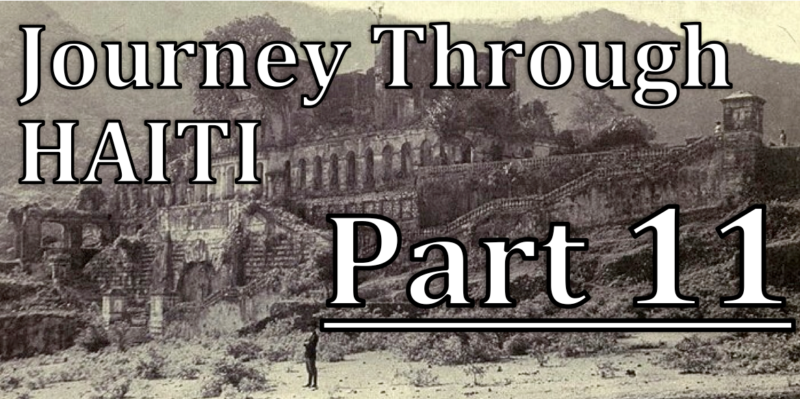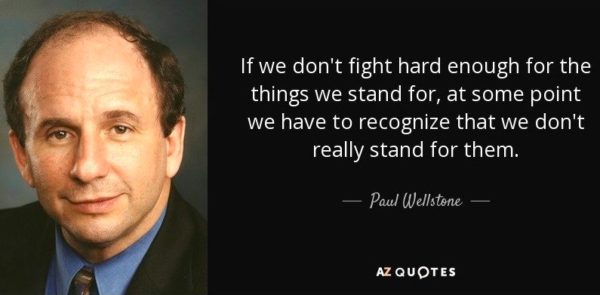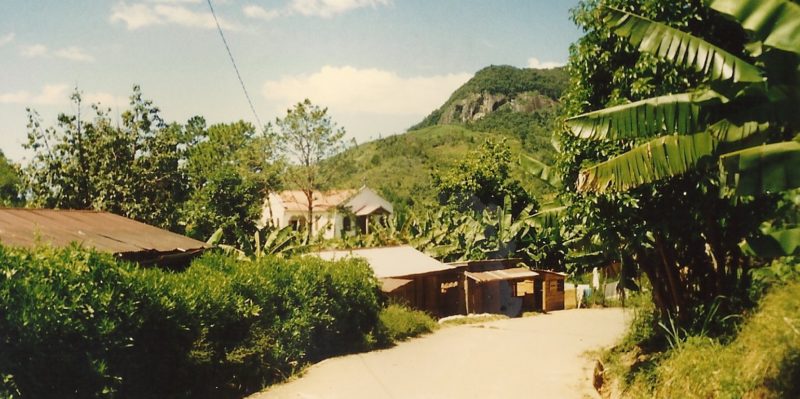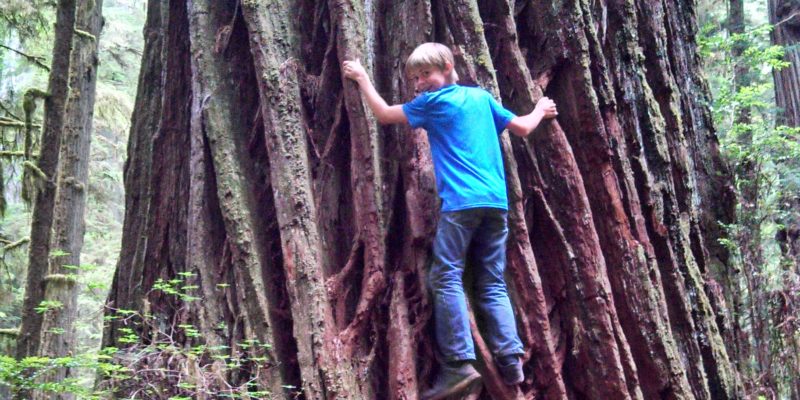Up in the mountains, high above all the crap in the Port au Prince valley, sits a quaint town called Kenscoff. Up here it rains a lot and the air is clean. The mountains back here are incredibly steep, jutting up like dorsal fins on a shark. The Tetons are this steep, but they are hard rock. These are dirt and people have cleared almost every tree in sight.
They farm the hillsides. I don’t know how they do it because I would be afraid even to walk in these fields. One misstep and you would tumble thousands of feet to the bottom of the valley. There are erosion scars that would swallow a skyscraper.
I came up here to meet a woman named Jane Wynne. She is living a sustainable life and her property is full of lush vegetation. Her father was an agronomist and civil engineer with degrees from Harvard and MIT. He came to Haiti in 1925 from Albany, NewYork and in 1956 he started a reserve in the mountains to protect the native plant species at this altitude He spent his life studying the best ways to maintain top soil and produce the highest yielding crops without using pesticides or herbicides. He died in 1994 and Jane has been tirelessly promoting her father’s cause ever since. Jane went to high school and college in the United States then returned to her Haitian home to work and learn by her father’s side.
Just given that background, it’s clear Jane is not a typical Haitian. Her home is in Kenscoff, which is a forty-five minute hike up to the summit of the mountain at Obleon, which has an elevation of about 5000 feet. It’s on the summit where the 30 acre preserve is.
Jane’s home in Kenscoff is brimming with character. Her one acre plot is lush with tropical plants, several species of bamboo hide the outside world. There are vegetable gardens, fruit trees, and her compost piles. Little trails lead down and around her sloped shady property. Her house is an old colonial style home with tall narrow shutters and mosaic tile floors. Her veranda is encircled in multi-colored Buddhist prayer flags someone once gave her. People are always coming by her home, every day, several times a day. A group of Haitian college students were leaving soon after I arrived. They had spent the day up at the preserve. A man from Boston came by while I was there to discuss micro-finance options for farmers in the area. A neighbor from Greece, a family from Miami, locals who just hang out there. I commented that this place is a place of legends, like Ken Kesey’s home in La Honda, California in the early 1960’s that inspired the likes of Jack Kerouac, Tom Wolfe, Hunter S. Thompson, Allen Ginsberg, and others. “Really, you think so,” Jane asked. Then she turned to another regular visitor, “what ever happened to that guest book we used to have. We should put that out again.”
It was refreshing to meet someone like Jane, coffee was always available from the hand pressed server, perhaps there would be tea or a bottle of wine. The electricity was out at her house so we cooked by candle light in old cast iron pans blackened from years of use. It was like camping. It was also cold. Jane lent me a wool poncho. Her world-traveled future son-in-law broke out the whisky and we played an assortment of bongo drums as he told me how bamboo and hemp can save Haiti. It got down in the lower sixties at night. There was a little guest house with a bed, but I hung my hammock beside the bed and slept there instead, because that thing is so damn comfortable. Really, it is. I wrapped myself in a quilt at night in my hammock to just to keep warm, which is a stark contrast to sleeping back in Port au Prince where I shed my clothes at night just to keep from sweating.
This place was a good stop for me. It was something completely different to everything else I had been seeing in Haiti. I saw how Jane’s place can play a role in the environmental education of young Haitians. It’s a place where bold ideas are not only entertained, they are encouraged. This is unusual for Haiti. Jane’s family has been preaching sustainability for decades on what seems to have been a losing battle. But all hasn’t been for naught. Because even though they have been preaching from the mountain top and have been watching that mountain gradually wash out to sea with each passing rain, at increasing rates, Jane and her father have been the keeper of the light. At this little home in the mountains, and at the preserve at the summit, the Haitian Lorax lives. And as long as there is someone around willing to keep telling the story, there remains hope. Perhaps one of those school kids I saw retrieving her school bag from the veranda will grow up to be the President of Haiti. That’s about the only way the last Truffula tree can be saved.
Last Monday, when I left Jane’s home, I headed up the mountain on the motorcycle to Obleon and the preserve. I was thinking about going all the way down the backside to the south shore, the adventurer in me wanted to, but Jane told me a tale of her friend who recently died on a motorcycles on that road, falling a thousand feet off the edge when he rounded a tight cut-back and swerved to miss some people who were walking. I saw people in these four-wheeler/dune-buggy contraptions heading south and perhaps there was a reason they were on four-wheelers. I was told the road is death trap by several people.
In any case my decision was made before I even got down the side road to Jane’s preserve. This side road had two paved tire-tracks heading down a super steep curve. I thought to myself, if I had to stop, I don’t know if I could keep the motorcycle in place without skidding down, and this was on dry concrete, not slick mud. I pulled the bike off the road at a little driveway that lead into a radio tower and parked it. I walked the rest of the way down to the preserve. I certainly wouldn’t be testing the muddy highway south down the backside of the mountain to the sea, not by myself at least. (Upon subsequent observations using Google earth “Yikes!”, I no longer have any doubts that I made a wise decision.)
Jane rents out part of the preserve to USAID. They have created a series of research plots to show various plant species and to demonstrate growing methods. They use this as a place where local farmers can come and learn new terracing techniques and other helpful things.
As I was leaving, I met a Haitian employee, Charles, who spoke English and had gone to college at South Dakota State University. As we talked, we realized we had similar ideas about crafting a study abroad program in Haiti for American students. His goals focused on sustainable agriculture, but he quickly appreciated how this fits perfectly into a broader program in sustainable development. Before long we were in the regional director’s office talking about the potential role for USAID in acting as the in-country host organization for this study abroad program. I am cautiously optimistic that the “Yes we will do this” was given with the proper authority to say yes and was sincere, and not just a “I’ll say yes so you will leave my office.”
In any other country, I could create a study program in partnership with a local university in that country, or I could register as a foreign organization doing business in the country and run everything myself. In Haiti, both of those approaches would mean the death of our goals. Anything that would increase the oversight by the Haitian government would mean all of our time would be spent dealing with bureaucracy rather than with practical teaching logistics. If this program could fall under an existing USAID framework, we potentially would need less interaction with Haitian government people asking for bribes.
The next step will be to approach schools on the United States to be the primary home for the program. The home school would ensure the accreditation of the curriculum, enroll students from various universities and issue the college credit. There is lots of planning to go, but on one of my last days on Haiti, this is the closest I’ve come to seeing a potential role for me here. I need to think more about the goal and nature of any potential study abroad program. Is it for students, or an alumni trip? How long should the program be? Can this be a program with time spent comparing issues to the Dominican Republic? Is there an opportunity to bring in Haitian students for part of it? Is this really what I want to get involved in?
Finding people to teach different segments won’t be a problem if it’s an American institution paying their wages. It’s only a problem to find professors for Haitian universities because Haitian government run universities haven’t been regularly paying their staff. And so it’s not uncommon for the professors here to skip class because they are at their other job, the one with a steady income.
Two more potential projects Charles told me about were his plans to plant 200,000 trees on one mountainside, and his plans to plant 1,000,000 in another location. This interests me because I might be able to help him obtain funding. One possible way to get funding is by creating property rights agreements between land owners and foreign investors for the rights to any carbon offset credits that could be potentially be granted under a carbon monitoring scheme. (Because trees absorb carbon dioxide, they offset human activities that emit carbon dioxide) These carbon reduction credits, which can be issued by certified evaluation organization, can be worth lots of money to businesses that are required to meet certain emissions regulations or to businesses that voluntarily want to offset their current emissions so they can claim they are carbon neutral. All in all, it’s confusing and complex, which is why an attorney, such as myself, might be able to help facilitate these tree planting plans.
After this very interesting stop at Jane Wynne’s farm, I felt as of I had finally accomplished something here in Haiti (besides writing these blogs). I had some ideas I can toss around after I get back to the States. They may take off, they may not, but it’s something. So in a good mood, I rode down the mountain toward crappy Port au Prince, but this time I did not stop. I kept riding to a place more remote and serene than any place I had yet been in Haiti. I’ll post that story in a couple of days.




